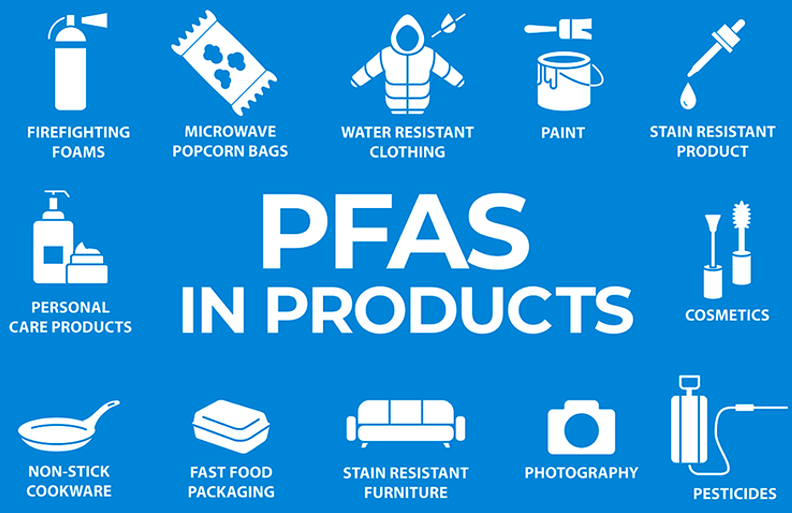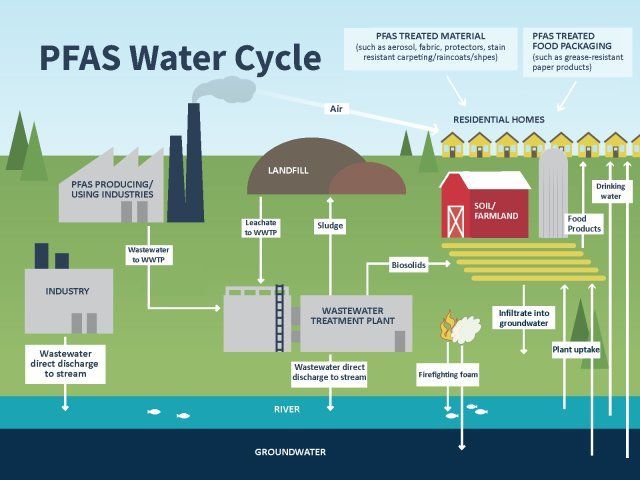What happened?
On October 2, 2020, the
Massachusetts Department of Environmental Protection
(MassDEP) published its PFAS public drinking water standard or Massachusetts Maximum Contamination Level (MMCL) of 20 ppt for six (6) per- and polyfluoroalkyl substances (PFAS) including: perfluorooctane sulfonic acid (PFOS); perfluorooctanoic acid (PFOA); perfluorohexane sulfonic acid (PFHxS); perfluorononanoic acid (PFNA); perfluoroheptanoic acid (PFHpA); and perfluorodecanoic acid (PFDA).
On April 10, 2024, the
Environmental Protection Agency (EPA) established a National Primary Drinking Water Regulation (NPDWR) setting enforceable Maximum Contaminant Levels (MCLs) for six specific PFAS in drinking water. This includes individual MCLs for PFOA, PFOS, PFHxS, PFNA, and HFPO-DA, and a combined Hazard Index MCL for PFAS mixtures with two or more of PFHxS, PFNA, HFPO-DA, and PFBS. Additionally, the EPA set non-enforceable health-based Maximum Contaminant Level Goals (MCLGs) for these chemicals.
Maximum Contamination Level Goal (MCLG):
The level of a contaminant in drinking water below which there is no known or expected risk to health. MCGLs allow for a margin of safety and are non-enforceable public health goals.
The Hazard Index is a tool to evaluate potential health risks for exposure to chemical mixtures. *ppt = parts per trillion (also expressed as ng/L)
The EPA's final rule requires:
- Public water systems must monitor for these PFAS and have three years to complete initial monitoring (by 2027), followed by ongoing compliance monitoring. Water systems must also provide the public with information on the levels of these PFAS in their drinking water beginning in 2027.
- Public water systems have five years (by 2029) to implement solutions that reduce these PFAS if monitoring shows that drinking water levels exceed these MCLs.
- Beginning in five years (2029), public water systems that have PFAS in drinking water which violates one or more of these MCLs must take action to reduce levels of these PFAS in their drinking water and must provide notification to the public of the violation.
What is PFAS?
Where did PFAS come from?
- Industrial Sites: PFAS are used in various industrial applications, including aerospace, automotive, construction, and electronics. Factories that manufacture PFAS compounds or use them in production can release these chemicals into the air, soil, and water.
- Firefighting Foams: PFAS are key ingredients in certain firefighting foams, particularly those used for fighting oil and gasoline fires at airports, military bases, and other sites. These foams can contaminate local water supplies and soil.
- Consumer Products: Many consumer goods contain PFAS due to their water-resistant and stain-resistant properties. These include products like non-stick cookware (e.g., Teflon), waterproof clothing, stain-resistant carpets and fabrics, and some food packaging materials.
- Waste Disposal: Landfills can become a source of PFAS contamination, as products containing these chemicals break down and leach into the environment. Wastewater treatment plants can also contribute to PFAS pollution if they process industrial waste or sewage containing these chemicals.
- Water Contamination: PFAS can contaminate drinking water supplies when industrial discharges, landfill runoff, or firefighting foam seeps into groundwater or surface water sources.
Due to their strong chemical bonds, PFAS do not break down easily in the environment. This persistence can lead to widespread environmental contamination and exposure risks for humans and wildlife.
Has PFAS been found in Lunenburg Water District's Water Supply?
Tests have detected the presence of PFAS in the water supply of the Lunenburg Water District at levels concerning public health. The highest level of detection of PFAS in Lunenberg’s active wells (Keating and Lancaster Avenue Wells) was 8.58 ppt, with the Hickory Hills Well at 38 ppt. The Hickory Hills Well is presently offline due to elevated levels of manganese.
Should private well owners test for PFAS?
Are there filters that remove PFAS?
Point of Use (POU) water treatment devices treat the water at one fixture in a home, such as a kitchen faucet. Point of Entry (POE) water treatment devices treat all of the water for the main water line serving a whole house.
You may use a POU or POE treatment device to remove PFAS6. However, before installing any treatment device for drinking water, you should get your water tested, because the type of treatment device you select will depend on the level of specific PFAS in the water. You should also test your water after the treatment device is installed to verify that it is removing PFAS to levels less than 4 ppt for the sum of PFAS6.
Ingestion of water with elevated PFAS is the main health concern, rather than other uses such as showering or use of the water for laundry. Therefore, installing a POU treatment device for drinking or food preparation in the kitchen, e.g., under a kitchen sink, may be a good option and location for a treatment device.
Any treatment device you use should be certified to meet the National Sanitation Foundation (NSF) standards to remove PFOS and PFOA compounds so that the sum of their concentrations is below 4 ng/L. If you choose to install a treatment device, you should check to see if the manufacturer has independently verifiable PFAS6 monitoring results demonstrating that the device can reduce PFAS below 4 ng/L. In addition, to verify that the device achieves PFAS6 levels less than 4 ng/L you may need to resample your water after the treatment device has been installed.
For more information about PFAS and private wells, please visit:
https://www.mass.gov/info-details/pfas-in-private-well-drinking-water-supplies-faq#should-i-test-my-private-well-for-pfas?-
Why is PFAS a Concern in drinking water?
- Cancer: Some studies have found associations between PFAS exposure and increased risk of certain types of cancer, particularly kidney and testicular cancer.
- Immune System Effects: PFAS exposure has been linked to immune system suppression, potentially reducing the efficacy of vaccines and increasing susceptibility to infectious diseases.
- Thyroid Disease: Research suggests that PFAS can disrupt thyroid function, which can lead to various metabolic issues and health complications.
- Reproductive Issues: PFAS have been associated with adverse reproductive outcomes, such as decreased fertility and developmental delays during pregnancy and infancy.
- Liver Damage: Exposure to certain PFAS compounds has been connected to liver damage and changes in liver function.
- Cholesterol Levels: There is evidence that PFAS exposure may lead to increased cholesterol levels, a risk factor for heart disease.
- Developmental Effects: PFAS can affect growth, learning, and behavior in infants and older children.
What is being done to reduce PFAS levels in our drinking water?
The district has been actively monitoring the situation and has taken proactive steps to address these findings by working with Tighe & Bond on the PFAS Water Master Plan. Together we proactively applied for
MassDEP’s Drinking Water State Revolving Fund (DWSRF) 2024 Intended Use Plan and the district was approved for $14.9M in funding for the reactivation of the Hickory Hills Water Filtration Plant to remediate the elevated levels of manganese and PFAS.
The DWSRF is a joint federal-state financing program that provides subsidized loans and grants to protect public health by improving water supply infrastructure systems and protecting drinking water in the Commonwealth. The district has been approved by MassDEP for a 0% interest rate with a minimum of 3.3% loan forgiveness.
What is a PFAS Water Master Plan?
- Assessment: Identifying the sources and concentrations of PFAS in the water supply through extensive testing and environmental assessment.
- Regulation Compliance: Ensuring that water quality meets or exceeds regulatory standards set by local, state, and federal environmental agencies.
- Treatment and Remediation: Implementing treatment technologies to remove PFAS from contaminated water sources and prevent future contamination. This can involve advanced filtration systems, such as activated carbon treatment or reverse osmosis.
- Public Health Protection: Protecting public health by reducing exposure to PFAS through the water supply. This involves effectively communicating risks and treatment measures to the public.
- Monitoring and Research: Establishing ongoing monitoring programs to track the levels of PFAS in water sources and researching new treatment methods and technologies.
- Stakeholder Engagement: Engaging with community members, industry stakeholders, and governmental bodies to inform and involve all in decision-making processes.
- Financial Planning: Developing a financial strategy to fund the necessary infrastructure upgrades, treatment technologies, and ongoing monitoring efforts.
Where does our source water come from?
The water supply for the Lunenburg Water District includes 4 active wells and one inactive well on Lancaster Avenue. MassDEP I.D. numbers for these wells are 01G, 02G, 04G and 07G, the inactive well is 03G. We also have an additional well located near Hickory Hills Lake (06G). This well has been classified as inactive as well. Our most recently installed well (2010) is located on Leominster Shirley Road called the Keating Well (08G). Keating Well has full generator backup, and 2 of the Wells on Lancaster Avenue have mechanical gear operators that allow water to be pumped without electricity.
Why was the Hickory Hills Lake Well chosen for reactivation and for the water filtration plant?
The Hickory Hills Well was selected due to the elevated levels of PFAS6 (38 ppt) and manganese; as well as its ability to offer much needed system redundancy once the Water Filtration Plant is constructed. It has always been a goal of the Lunenburg Water District to bring the Hickory Hills Lake Well back online. The MassDEP ranks projects for SRF funding using an established rating system which assigns points based on various criteria. These criteria include the extent to which the project:
- Eliminates or mitigates a public health risk
- Achieves or maintains compliance with applicable drinking water quality requirements
- Provides affordable solutions to users in the service area
- Consolidates or restructures a public water system
- Implements, or is consistent with, watershed management plans (or addresses a watershed priority) and is consistent with local and regional growth or infrastructure plans
The condition of the Hickory Hills Well prioritized MassDEP’s SRF funding, and if granted it would reduce the burden of these costly upgrades for the community through a low interest loan with principal forgiveness. Without this funding once the EPA enacts the NPDWR to legally enforce the MCL for PFAS in public drinking, the Lunenburg Water District will be required to make these costly upgrades and funding opportunities will become more competitive.
The following table presents the estimated budget for to bring the Hickory Hills Well online and remediate PFAS in Lunenburg, comparing two financing options: State Revolving Fund (SRF) loans and Bond rate loans. SRF loans offer lower interest rates and principal forgiveness. Bond rate loans, on the other hand, are funded by selling municipal bonds to investors and may vary in interest based on perceived risk.
How will this impact my water bill?
If approved by the voters, an increase in water bills is anticipated to occur at the completion of the construction of the Water Treatment Plants somewhere in the vicinity of 2027/28. The SRF loan offers 0% rates and a minimum of 3.3% principal forgiveness. Bond rate loans, on the other hand, are funded by selling municipal bonds to investors and may vary in interest based on perceived risk.
The following is a preliminary budget to provide a general idea on average of the increase to quarterly water bills based on the finance options and rates available at this time, State Revolving Fund (SRF) loans and Bond rate loans over 20 and 30 years:
*The Keatings Well did not qualify for SRF Funding in 2024; it is the district’s intent to apply for funding for the remediation of PFAS in the Keatings Well in August for consideration for SRF Funding. Interest rates are subject to change, and the budget figures provided are preliminary estimates. These numbers will not be finalized until the District formally decides to secure the funding.
It is important to note that the EPA has advised us that the Keating Well tested above the EPA’s Health Advisory for PFOA and PFAS at 4 ppt. The Keating Well will need to come off-line while source filtration is installed. When the Keating Well is off-line the system will need a redundant supply of water, the Landcaster Wells are not capable of long run times, especially during peak season. By placing the Hickory Hills Lake Well back online with a new water filtration plant, it provides much needed system redundancy for operation and maintenance; and allows for upgrades throughout the system. The intent is to only operate the Hickory Hills Wells when necessary, providing a redundant source of water during periods of maintenance.
What are the next steps?
- Tighe & Bond and the Lunenburg Water District have developed the PFAS Water Master Plan to create a pathway forward to remediate PFAS from our system.
- The MassDEP issued a final decision regarding the Drinking Water State Revolving Fund 2024 Indented Use Plan on March 26, 2024, awarding the Lunenburg Water District $14.9M for the Hickory Hills Water Filtration Plant. 2024 Final DWSRF IUP
- If awarded, the Community will vote on whether to accept the funds in May of 2024.
- Should the community vote to accept the funding, a contractor will need to be selected by June of 2025.
Our greatest concern is always our customers and protecting public health and safety. Should you have any questions or concerns, please feel free to contact us at
waterquality@lunenbergwater.com.





